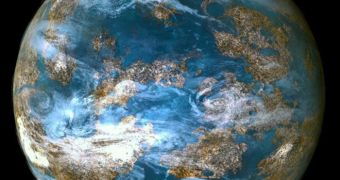According to the conclusions of a new study that will be published in the January 20 issue of the esteemed Astrophysical Journal, it would appear that super-Earth-class exoplanets are very likely to feature continents as well, not just watery surfaces as experts had previously suggested.
Super-Earths are relatively common outside our solar system, making up an important percentage of the 3,500+ exoplanetary candidates NASA's Kepler Space Telescope has identified to date. These worlds received their designation because they are rocky like Earth, but feature larger masses.
Due to the extra weight, these planets are also heavier than our own, meaning that they exert a stronger gravitational pull on their own surfaces. Astronomers until now believed that this stronger pull would level continents, forcing any potential oceans to overflow their basins and inundate all surfaces.
The new investigation suggests that this may not always be the case. The work was led by Northwestern University astronomer Nicolas Cowan and University of Chicago astronomer Dorian Abbot, Astrobiology Magazine reports.
“We often imagine that the water will end up at the surface – at least that's the standard picture for exoplanets. But on Earth, the water is partitioned between two reservoirs: the ocean and the mantle. That interior reservoir can be comparable in size, if not bigger, than the surface reservoir,” Cowan says.
For this study, investigators considered a scenario where the gravitational pull and sea floor pressure on these alien worlds are intertwined. The high pressure would push water into the planets' mantles. “We can put 80 times more water on a super-Earth and still have its surface look like Earth,” the expert adds.
Additionally, plate tectonics may also play a role in moving surface water into the mantle. If super-Earths are tectonically-active, then they have to have both oceans and continents, the team argues.
The implications of this study may be far-reaching for the field of astrobiology, which deals with finding Earth-analog locations in space. The presence of continents on super-Earth that orbit their parent stars inside the habitable zone could imply that life has the potential to develop there.
Cowan says that experts currently do not know how much water is in Earth's mantle. It could be that up to an ocean's-worth of the liquid may exist beneath the surface, but this is just an estimate. This degree of uncertainty makes predictions about super-Earth approximate at best.
Finding if there are plate tectonics on super-Earths, and figuring out how much water is in Earth's mantle “are the two things we would like to know better to improve our model. Our model is a shot from the hip, but it’s an important step in advancing how we think about super-Earths,” Cowan concludes.

 14 DAY TRIAL //
14 DAY TRIAL //